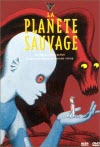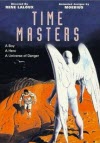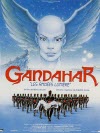The Illustrated Man
Raz Greenberg looks at the career of French animator, René Laloux.
Animated science-fiction features aimed at the adult audience are considered today to be almost exclusively in the domain of Japanese filmmakers. However, years before Katsuhiro Otomo’s Akira or Mamoru Oshii’s Ghost in the Shell, French animator René Laloux (1929-2004) practically pioneered the field with his debut feature-length film, Fantastic Planet (1973). Laloux went on to direct two additional features, Time Masters (1982) and Gandahar (1988) and, although neither was as good as his debut feature, both are worthy of discussion as part of his overall work and its themes.
Laloux spent his adolescent years under the Nazi occupation of France, and the struggle against tyranny and oppression is a significant element in his works. He worked in a variety of day-jobs while developing his interest and skills in different forms of art, from woodcarving to painting. In 1956, he began working in La Borde, a psychiatric institute that encouraged unorthodox and alternative treatment of patients. Laloux led painting and shadow-puppetry workshops in the institute, and this job inspired his first filmmaking efforts. One of his short films caught the attention of renowned cartoonist Roland Topor, and the two began a series of collaborations that would lead to the production of Fantastic Planet.

Originally titled La Planète Sauvage (The Savage Planet), the film is based on Oms En Serie, a novel by one of France’s greatest science fiction writers, Pierre Pairault (who wrote under the pen-name Stefan Wul). The story takes place on the planet Ygam, a world populated by the Draags — a race of giant, bald, blue-skinned and red-eyed creatures. The Draags are a technologically advanced culture, and many of them keep members of a primitive race — human beings known as “Oms” — as their pets. The film’s protagonist is Terr, an Om child who is taken as a pet by a Draag girl, manages to educate himself, joins a tribe of free Oms, and helps them in their struggle to survive.
Fantastic Planet was animated using cutouts, and the limited animation often gives the film a static feeling. But this feeling, enhanced by Alain Goraguer’s downbeat score, contributes to the atmosphere by characterizing Draag society. It is a static culture, in which the long-living individuals pass the time slowly in meditation, confident in their life of comfort — a sharp contrast to the humans, whose short lives are a continuing struggle, either to please their Draag masters as pets or to survive on the harsh surface of Ygam.
Topor’s designs for the film also enhance the alien atmosphere of the Draags’ world. The Draags’ architecture and technology combine medieval design with an organic look, almost like an extension of the aliens’ bodies. Visualizations of the Draags’ meditation practices involve changes in their look and surreal trips inside their minds, further contributing to the film’s portrayal of a distant, non-human culture. The wilderness of this world feels equally alien, filled with mutated animals, twisted plants, and other dangers that lurk everywhere.
The film centers on Terr’s attempts to fit into the society of free humans. The process involves both his own education about survival and his educating the reluctant free human community with what he has learned about the world during his time in Draag captivity. The need for both kinds of knowledge is demonstrated in one of the film’s most horrific sequences, in which the Draags decide to “de-contaminate” the humans’ living area, using genocide-warfare tactics. It is Terr’s ability to read the Draags’ language that enables him to warn the human community about the coming attack, while the survival tactics developed by the same community over a long period save it from extinction.
However, the film does not conclude with the humans finding freedom and peace away from the Draags, or in a victory for the humans over their oppressors. Instead, it demonstrates how the Draags are also victims of their own worldview that regards the humans as pests. The Draags and the humans learn to co-exist and each side benefits from knowledge of the other.
Fantastic Planet is not a perfect film. There is almost no character development, dialogue is stiff, the film relies too heavily on narration to push the plot forward (especially in its early parts), and the ending feels rushed. But it remains an impressive atmospheric visual work that few other movies — in animation and live action — have managed to equal, with themes that are still thought-provoking. It also opened the door for other serious science-fiction animated productions, including Laloux’s later films.

Following the success of Fantastic Planet, Laloux was involved in an ambitious project aimed at adapting other novels by Pairault into a series of hour-long TV animated specials. Almost a decade after the release of his debut feature, the only output of that project was the release of his second theatrical film — Time Masters (originally titled Les Maîtres Du Temps). Despite being based on a novel by the same author, Time Masters has an altogether different feeling from Fantastic Planet. Whereas Fantastic Planet is a grim dystopian tale about people trapped on a hostile planet, Time Masters is a grand scale space-opera adventure that takes its protagonists on a lengthy voyage across different exotic locations.
The opening scenes of Time Masters bring to mind the opening of Laloux’s previous movie — featuring a young boy named Piel who finds himself trapped on a desert planet populated with hostile creatures. Before dying, the boy’s father manages to send a distress signal to his friend, daring space-pilot Jaffar. Able to speak with Piel through an interstellar transmitter, Jaffar immediately embarks on a journey to save the boy, but he is met with resistance from one of his passengers, dethroned prince Matton who is on the run from his people after stealing their treasure.
Laloux’s artistic partner in the production of Time Masters was Jean “Moebius” Giraud, considered at the time to be the boy-wonder of French comics due to his work on ground-breaking titles such as The Airtight Garage and Arzach. Giraud also contributed designs for the high-profile Hollywood productions Alien and Tron, and his works provided the visual inspiration for Blade Runner. Topor’s surreal-painting atmosphere, enhanced by the cutout animation in Fantastic Planet, was replaced by Giraud’s comic-book aesthetic in Time Masters, this time presented in traditional cell-animation. The innocent wide-eyed boy, the muscular square-jawed hero, the scheming prince with more than a slight touch of femininity in his design, the Nordic-looking beautiful princess, the short and fat wise old man — all the familiar character archetypes are there, set against a rich backdrop of imaginatively designed technological props and alien worlds (now painted in bright colors, as opposed to the dark palette of Laloux’s previous feature). Though many of these visual elements feel all too familiar, Giraud and Laloux’s work gives them a polished feeling, miles ahead in terms of quality of American attempts to produce animated genre work at the time (noticeably in Ralph Bakshi’s films).
Unfortunately, the film’s impressive designs are wasted on a rather dull script. The film divides the audience’s attention between the voyage of the young boy lost on a hostile world and the space pilot’s journey to rescue him, and neither plotline is particularly involving. The former is a slow-moving affair with few minutes of real excitement, and the latter spends too much time on explanations and side-stories. Both plotlines also feature redundant comic-relief characters that get in the way of the film’s attempt at doing a serious drama.
Two sequences in the film attempt to give it the same thematic depth that characterized Fantastic Planet. The first, which takes place on a planet where a mysterious creature turns living beings into mindless, featureless slaves, echoes Laloux’s debut feature in its anti-oppression message. But like many other elements in script, it feels out of place with the general plot. Likewise, the ending features a time-travel twist that could have been considered clever if the rest of the film led to it in a logical way. Alas, it feels like something that was added in the last minute.
The attractive visuals of Time Masters make it a more accessible film than Fantastic Planet, but the lackluster script fails to keep an interest in the plot for long. Reportedly, both Laloux and Giraud were also unhappy with the end result.

Laloux’s third and final feature, Gandahar, was released in 1988, and appears to be an attempt to balance between the distinct approaches of his two previous films. In many ways it succeeded: like Time Masters, the film has the narrative structure of an adventure story, this time in the style of Edgar Rice Burroughs’s novels, but it also carries some of the deeper themes of Fantastic Planet, as well as some of the disturbing, alien feeling of that movie.
Based on a novel by Jean-Pierre Andrevon, the film takes place on an alien planet where a matriarchal society of blue-skinned humanoids leads an ideal life. When a mysterious force starts turning the planet’s inhabitants into stone statues, planet-ruler Ambisextra sends warrior-supreme Sylvain to investigate. In the course of his journey, Sylvain faces many dangers, falls for a beautiful girl, and learns some disturbing truths about his world.
The pulp-adventure nature of the plot sometimes makes it hard to take the film seriously. Some of the dialogue is corny (especially in the scenes describing the relationship between the protagonist and the girl of his dreams), and having most female characters walk around bare-chested gives the film an exploitative feeling. The story is, however, well-paced and manages to keep things interesting, as it develops in more complex directions. Initially it appears to be a simple story about the struggle between a peace-loving culture and an oppressive culture, a story that’s all too familiar from Laloux’s previous films. As the film progresses, however, it turns out that the peaceful and technologically-advanced culture has achieved its ideal living at a price, and actually brought the coming Armageddon upon itself. It is almost as though the film re-tells the story of Fantastic Planet, only from the Draggs’ perspective. The time-travel twist towards the end of the film brings Laloux’s previous feature, Time Masters to mind — but in Gandahar this twist fits the story in a way that makes sense.
In making Gandahar, Laloux again employed the services of a leading French comic artist — Philippe Caza, renowned for his science-fiction works. Like the script, Caza’s designs appear to combine elements from Laloux’s two previous films: there are the above-mentioned comic-book archetypes of the bold male hero and his delicate female companion, but there are also stranger visuals that feel less “exotic” and more alien. Standouts include a community of horribly deformed people, an unstoppable army of metal men, various forms of technology employed by the planet’s inhabitants based on animals and plants, and nuances that distinguish between the lifestyle of planet’s elite society and the more common population. The coloring palette also maintains a nice balance between the typical colorful look of an adventure story and the darker tones that fit the more serious aspects of the film.
Though Gandahar does not reach the thematic depth of Fantastic Planet — the film seems to run back to safer and simpler territory whenever things appear as though they’re about to get too complicated — it is Laloux’s most entertaining work, one that I suspect would meet with great enthusiasm among contemporary fans of science-fiction animation. It serves as the best introduction to Laloux’s work. Sadly, it was also the director’s last feature before his death.
Throughout his career, Laloux also directed several animated shorts. One of the earliest, The Snails (1965), was his first collaboration with Topor, a comedy about a farmer’s attempts to grow vegetables in his garden with apocalyptic results. The absurd humor and cutout aesthetic bring to mind the animated shorts Terry Gilliam would work on a few years later, but the scenes featuring small humans on the run from giant creatures also hint of the director and the artist’s future work on Fantastic Planet.
In the 1980s, while working on Gandahar, Laloux and Caza created two other animated shorts. How Wang-Fu Was Saved (1987), is a beautifully illustrated, delicately colored and richly animated adaptation of a Chinese legend about an artist whose paintings are so life-like that they prevent people from seeing any beauty in real life. The film is something of a departure from Laloux’s usual political themes, and it works on deeper emotional levels than all his other films. The Prisoner (1988) is a more typical Laloux struggle-for-freedom tale about two boys who reach a city in which speech is forbidden. The limited animation and rough-line drawings bring to mind the director’s early work on Fantastic Planet, but despite some imaginative designs (especially the architecture of the city — a cross between medieval and futuristic look), there just isn’t enough in terms of plot in the film to keep viewers interested, and the conclusion feels rushed.
In 2003, Caza worked as writer and designer on the animated feature Les enfants de la pluie (Children of the Rain), directed by Philippe Leclerc, a beautiful work of science fiction animation that seems to draw a lot from the artist’s previous work with Laloux.
Throughout the 1970s and 1980s, all of Laloux’s three features received theatrical release in English-speaking countries, usually dubbed. The release of Gandahar by Miramax, under the title Light Years, met with harsh criticism as it was heavily edited to fit into a more linear structure. Currently, only Fantastic Planet is available for home-viewing in North America. British distributor Eureka has released all of Laloux’s three features on DVDs, in their original French dub with English subtitles. Each disc contains a booklet detailing the film’s production process, and the above-mentioned animated shorts by Laloux are included as extras on the Fantastic Planet and Gandahar discs. These releases provide a wonderful opportunity to get acquainted with the pioneering director’s works.
There is plenty of material by Laloux on YouTube. Here are some examples.
A trailer, English-dubbed (the narration is a bit distracting, but the visuals are very representative of the film:
And a clip from the film itself:
Here’s a French trailer for Time Masters:
And here’s one for Gandahar:
If you enjoyed this article, please consider supporting Salon Futura financially, either by buying from the Wizard's Tower Bookstore, or by donating money directly via PayPal.